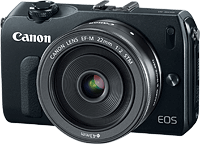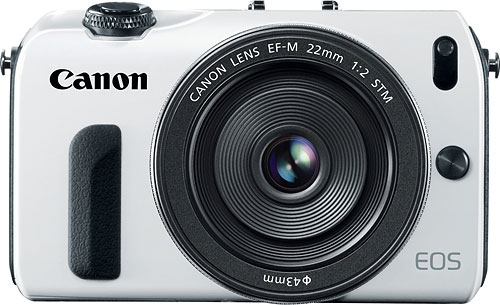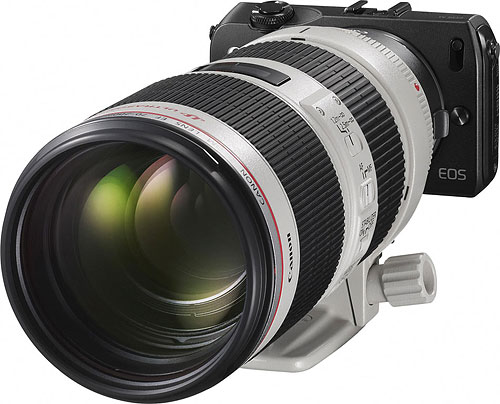Canon’s EOS M: Designed for purses, not for pros?
posted Thursday, August 16, 2012 at 5:10 PM EDT
 Late last week, the Japanese photo tech blog Impress DC Watch published a lengthy interview with several of the team at Canon responsible for planning and developing the company's first mirrorless camera, the Canon EOS M.
Late last week, the Japanese photo tech blog Impress DC Watch published a lengthy interview with several of the team at Canon responsible for planning and developing the company's first mirrorless camera, the Canon EOS M.
The interview contained quite a few interesting tidbits, but one stood out in particular, perhaps because to Western sensibilities it could seem rather sexist. The blogosphere promptly lit up with the assertion that Canon had labeled the EOS M as a camera for women. Commence to teeth-gnashing and wailing!
We weren't sure if the story made much sense, but it certainly picqued our curiosity. As senior editor Shawn Barnett noted in our hands-on preview of the EOS M last month, Canon's long-anticipated mirrorless debut strikes us rather a peculiar beast.
On the one hand, the EOS M seems aimed at savvy street shooters. Instead of a consumer-friendly built-in flash, you get only an external hot shoe. There are also some arcane multi-shot exposure modes that likely wouldn't be understood by the typical consumer. But those same street photographers would likely be put off by the lack of physical controls, a concession to the body size. And then there's the touchscreen, not really the hallmark of a camera aimed at enthusiasts or pros. All of which brings us full-circle: maybe this truly is a camera aimed at the full-auto shooter? But then there's that US$800 price tag, not to mention the choice of a 35mm prime as the sole kit lens...
Determined to get to the answer, we returned to take a closer look at the original DC Watch interview. Rather than relying on machine translation, which often loses the subtleties of the translated text, we had a native Japanese-speaker translate the article for us. For whom did Canon really feel it had built the EOS M--were the bloggers correct in their assessment?
It turns out they were in the ballpark, but perhaps still a little way off base. The quote in question came from Canon's Takeshi Tokura, a director in charge of EOS M product planning. Mr. Tokura did indeed say that the EOS M was aimed at females, but there was a little more to the comment. Specifically, he was talking about the approach in Canon's home market, where the company is targeting females in their 20s and 30s, who are just starting to develop an interest in photography.
That mirrors the strategy of the company's SLR cameras in Japan, where the most affordable entry-level models are sold under the EOS KISS brandname. The same cameras retail in the US market as EOS Rebels, and in much of the rest of the world with only EOS branding. Outside of Japan, the target customer (and the company's marketing strategies) for the EOS M will likely differ, just as it does for the SLRs. And even inside Japan, Mr. Tokura noted that he expects existing EOS DSLR shooters to adopt the EOS M as a second camera.
We also gathered a few other interesting details from the interview:
-
As with the EF / EF-S lens mount, Canon doesn't have plans to open the EF-M lens mount to third-party manufacturers. That means that--as they already do for SLR lenses--companies like Sigma, Tamron, and Tokina will need to reverse-engineer the EF-M mount should they wish to offer products compatible with the EOS M, and they'll continue to have to chase the ball as Canon makes changes to the mount's specification.
-
Canon is not yet considering phasing out its entry-level EOS Rebel / KISS models in favor of mirrorless cameras. Indeed, Canon's Hiroshi Kikuchi--a general manager in Canon's Design Center responsible for the mechanical design of the EOS M--suggests that there is still much room to downsize the company's SLR cameras.
-
Although he wouldn't be drawn on precisely when development of the EOS M began, Mr. Tokura did state that the plans had been on Canon's drawing board for "a long time". He also suggested that the reason for the company's late entry to the mirrorless market was that--until now--it couldn't hit its targets for the camera's size, weight, and image quality.
-
Despite the US$800 price tag, Canon sees the EOS M as being an entry-level camera. Mr. Tokura also suggested that he doesn't expect the EOS M to erode the company's SLR sales, stating that customers focused on photography will likely remain with a DSLR, while the compact system camera model would prove more attractive to those for whom photography is merely a means to an end. (Documenting a hobby, for example.)
-
Asked why the Canon EOS M didn't adopt the same sensor size used previously for the PowerShot G1 X, Mr. Tokura suggested that the image quality from that chip would not have been sufficient to merit the EOS brandname, and that a 3:2 aspect ratio was an absolute requirement for an EOS-series model. (The G1 X, incidentally, is said to be selling out its full 30,000 unit monthly production, and is apparently particularly well-received in Japan, Taiwan, and Hong Kong.)
-
Although the EOS M only goes on sale this October, Canon is expecting to capture an impressive 11% of the domestic Japanese market for mirrorless cameras in the second half of 2012. Monthly sales are expected to take up around 15% of the Japanese mirrorless market for the foreseeable future. Mr. Tokura believes mirrorless market share in Japan is now over 40% of the total interchangeable-lens market, and the company expects strong growth. A note of caution is sounded though; apparently even in Japan, some areas have mirrorless sales as low as 10% of the interchangeable-lens market.
Sadly, the interview didn't really answer our main question: just whom this camera was designed for, and what needs it best answers. It transpires that Canon simply spoke to its target customer inside Japan. The larger picture is something we'll have to answer for ourselves when we've had the chance to run the Canon EOS M through our in-depth review process. In the meantime, take a look at our Canon EOS M preview for more of Shawn Barnett's thoughts.

